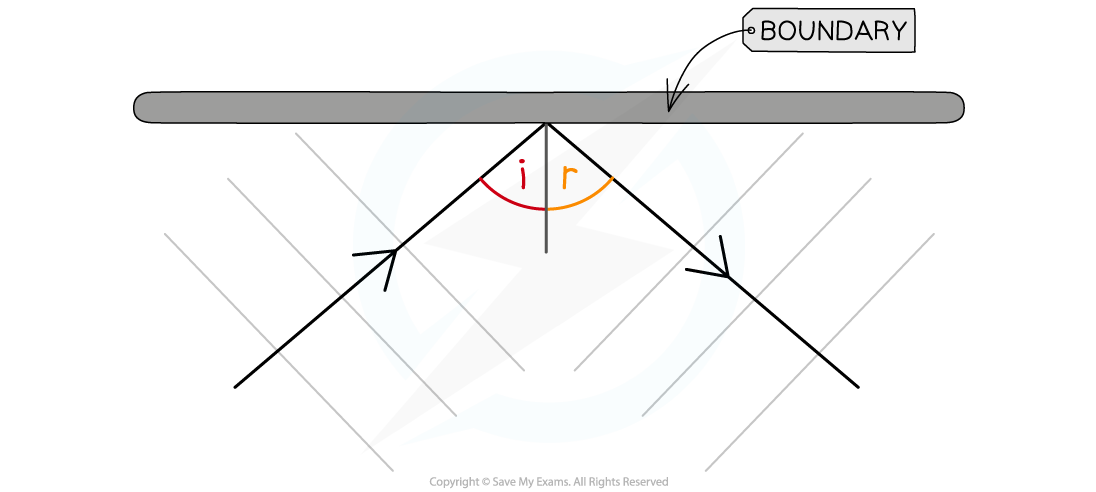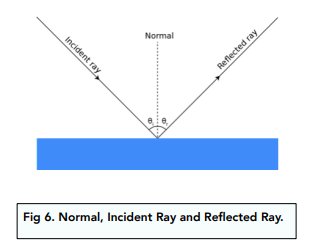Chapters
Let's look deeper into the intriguing phenomenon of wave reflection. When waves meet boundaries, something fascinating happens, i.e., they bounce back instead of going through. In this article, we'll uncover the rules that control reflection and learn about the angles involved: the angle at which the wave approaches (angle of incidence) and the angle at which it bounces back (angle of reflection). We'll also discover how different surfaces affect this bouncing back of waves.
Depending on material densities at a boundary, waves can exhibit various behaviours, such as:
- Reflection
- Transmission
- Absorption

Reflection of Waves
Reflection occurs when a wave encounters a boundary between media and remains in the original medium instead of passing through. In other words, when a wave travels towards a surface or edge and cannot continue through it, it reflects or "bounces off" the surface, changing its direction. This reflection can occur with various types of waves, including light, sound, and water waves.
Law of Reflection
To understand the law of reflection, you must be familiar with the angle of incidence and the angle of reflection.
Angle of incidence
When a ray of light or a wave approaches a boundary between two different media, such as air and water or air and a mirror, it is called the incident ray. The angle between the incident ray and the perpendicular (a line perpendicular to the surface at the point of incidence) is known as the angle of incidence.
Angle of reflection
After the incident ray strikes the surface, it is reflected. The angle between the reflected beam and the perpendicular is called the angle of reflection.
When waves encounter a boundary, they exhibit a distinct behaviour known as reflection. A critical characteristic of thought is that the angle at which the wave arrives, known as the angle of incidence, is equal to the pitch at which it bounces back, known as the angle of reflection. This relationship establishes a consistent pattern between the incident and reflected angles. This is known as the law of reflection:
The angle of incidence = angle of reflection
Some of the waves may also be absorbed or transmitted. Echoes serve as examples of sound waves being reflected off surfaces.
Material Boundaries
Material boundaries, where two different substances meet, play a crucial role in wave behaviour. When waves transition between materials, they encounter these boundaries, delineating the end of one sense and the beginning of another.
Reflection is a phenomenon that occurs when waves approach a boundary. As waves cross from one material to another, they reach this boundary. At this point, some of the waves may undergo reflection, bouncing back instead of progressing into the second material.

Examples of Wave Reflection From Everyday Life
- Imagine standing in front of a mirror, holding a flashlight. As you shine the light beam towards the mirror, something interesting happens. The light beam hits the mirror's surface and bounces back towards you. This is an example of wave reflection.
- Imagine standing by the side of a calm pond on a sunny day. You decide to toss a pebble into the water and watch as ripples form and spread outwards. As those ripples reach the pond's edge, something interesting happens. They bounce back and return towards you. This is an example of wave reflection.
How do Different Surfaces Affect Reflection?
Here's how different surfaces affect the reflection of waves:
- Flat surfaces: Flat surfaces tend to reflect waves more than other surface types. This is because when a wave encounters a flat boundary between two media, the incident angle equals the rise of reflection according to the law of reflection. The smoothness of the surface plays a role in determining the strength of the reflected wave.
- Smoothness and reflection strength: A surface's smoothness influences the reflected wave's power. A smoother surface tends to produce a more substantial reflection. A smooth surface allows for more coherent thought, with the wave bouncing off more organised and concentratedly.
- Rough surfaces: Uneven surfaces exhibit reduced reflectivity compared to flat and smooth surfaces. When a wave encounters a rough surface, the irregularities and imperfections on the surface cause the light to scatter in various directions. As a result, the reflected wave is weaker than a smooth surface.
- Opaque surfaces: Opaque materials reflect light not absorbed by the material itself. When light interacts with an opaque surface, the electrons within the fabric absorb the light wave's energy. Subsequently, the absorbed energy is reemitted as a reflected wave, resulting in the reflection of the incident light.
In short, flat surfaces tend to be more reflective, with the smoothness of the surface affecting the strength of the reflected wave. Rough surfaces scatter light in all directions, leading to reduced reflectivity. Opaque surfaces reflect light not absorbed by the material, where the material's electrons reemit the absorbed energy as a reflected wave.
Types of Reflection
Reflection can be classified into two types: specular and diffuse. Each type occurs under specific surface conditions.
- Specular reflection: Specular reflection happens when waves encounter a smooth surface. In this case, the reflected wave maintains the exact reflection angle as the incidence angle. This means that the incoming and outgoing waves follow a precise path, resembling a mirror-like reflection.
- Diffuse reflection: Conversely, diffuse reflection occurs when waves strike a rough or uneven surface. The waves interact with the surface irregularities, causing them to scatter in various directions. As a result, the reflected wave deviates from the angle of incidence, leading to a different angle of reflection. This type of reflection produces a scattered and less organised pattern.
In summary, specular reflection occurs on smooth surfaces, with the reflected wave following the same angle as the incident wave. Diffuse reflection occurs on rough surfaces, causing the reflected wave to deviate from the incident angle. Understanding these two types of thinking helps explain the different behaviours of waves when they encounter other surfaces.
Reflection Ray Diagrams
When we study reflection, we use ray diagrams to help us visualise wave behaviour. In these diagrams, we measure angles by comparing the wave (ray) direction to a line that stands upright, forming a 90-degree angle with the boundary.
How to Draw Reflection Ray Diagram?
- Establish the normal: Draw a line perpendicular (at a 90-degree angle) to the boundary. This line called the normal, serves as a reference for measuring angles.
- Draw the incident ray: Use a protractor to measure an angle from the normal. Draw a straight line along this angle using a ruler to represent the incident ray. Ensure that the line starts from where the wave approaches the boundary.
- Depict the reflected ray: Again, use the protractor to measure the same angle as before, but this time on the opposite side of the normal. Draw a straight line along this angle, ensuring it intersects the normal. This line represents the reflected ray.
Following these steps, you can create a diagram that accurately depicts the incident and reflected rays in reflection. The standard line helps establish the reference direction, and measuring the angles with a protractor ensures the diagram's accuracy.













You are the best,, coz you have gotten content about the topics
Hello ! Glad to hear that you’ve found the content useful!